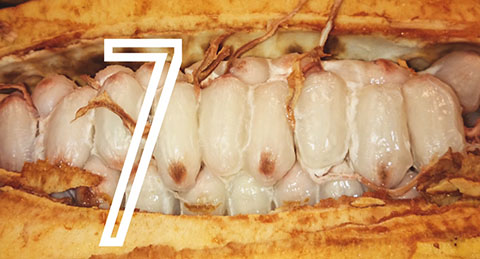ĪCacaos natural history starts in the steamy upper amazon, where the greatest center of genetic diversity still lies. The seeds from which chocolate is made form suspended in white sweet sour pulp inside large pods that grow from the trunk and branches of the cacao tree. After harvest this white pulp ferments around the beans. The fermentation changes the flavor of the bean. The beans are further processed and usually mixed with other ingredients to make chocolate drinks and foods. While all these post harvest processes are important to chocolate as we eat it, the root is the cacao tree and where it likes to grow. It normally grows as an under story tree, protected from harmful direct sunlight by taller trees. It grows best in a diverse forest system rather than a mono-crop system, which usually allows disease and pests to get a strong presence and devastate the trees. on the elevation and water and soil needs of cacao Encyclopedia Britannica writes:
Cacao thrives at altitudes of 30 to 300 meters (100 to 1,000 feet) above sea level in areas where temperatures do not range much below 20 °C (68 °F) or above 28 °C (82 °F). Rainfall requirements depend upon the frequency and distribution of rain and the degree of water retention by the soil; the minimum necessary rainfall is about 100 cm (39 inches) evenly distributed throughout the year, but 150–200 cm (59–79 inches) is optimal. Successful cultivation also requires deep well-drained soil that is porous and rich in humus. Protection against strong winds is necessary because of the tree’s shallow root system.
Notice that cacao needs lots of rain, and well drained soil. As Europeans colonists learned when they tried to grow cacao in an open plantation format, cutting down a rain forest creates extremely rapid soil erosion precisely because there is so much rain. The deep soil cacao wants is quickly washed away. We heard this same story from Gillian Goddard at the NW chocolate festival. Also notice in the Britannica quote above that protection against strong winds is another reason to grow cacao in a diverse forest ecosystem where it can be sheltered.
Our group (#7!) did a bit of research into Cote-d’Ivoire as an example of a major cacao region. We found a really interesting story that involves the natural history of cacao, the climate of the region, the world economy, and the history and present of the Ivory coast. Obviously we didn’t have time to learn everything about cacao in Cote-d’Ivoire -but some stuff anyway.
The French brought cacao to Cote-d’Ivoire during their colonial reign. When Cote-d’Ivoire became independent of France, its president Félix Houphouet-Boigny’s government supported good wages for workers and their products. As well as maintaining good relations with the French, the country became the leading cacao producer in the world.
